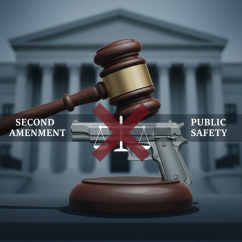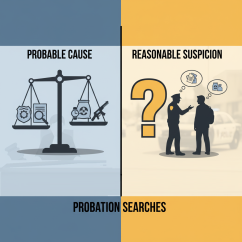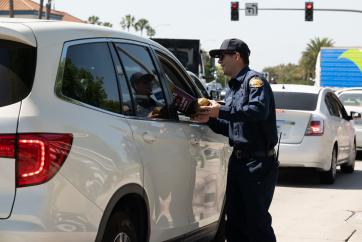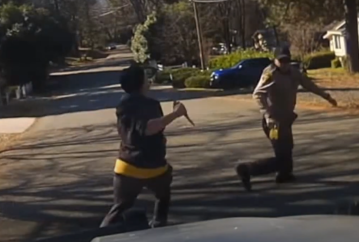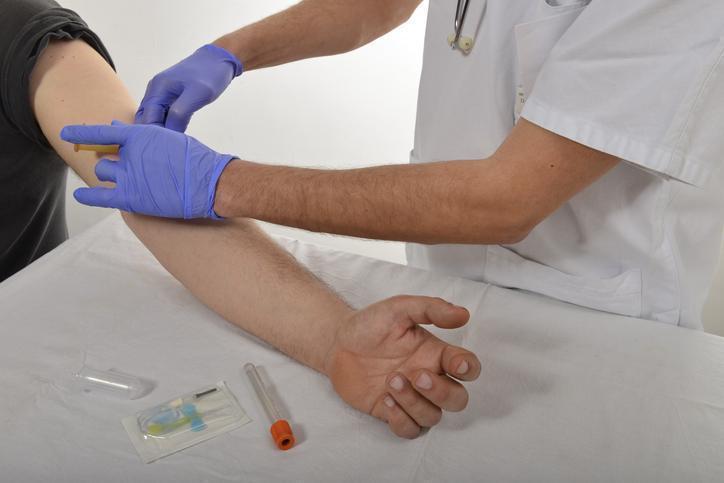

- Ref # CAC00131
- January 25, 2024
DUI Blood Draws and Implied vs. Express Consent, a Complex Issue
- Implied vs. express consent to a DUI blood draw
- Veh. Code § 23612(a)(5), DUI blood draws, and exigent circumstances
- Good faith
- Blood draws from a DUI suspect may be performed only after obtaining either a search warrant, a valid express consent, or under exigent circumstances with probable cause.
- The Vehicle Code’s implied consent provisions under V.C. § 23612(a)(5) do not constitute an express consent.
- A DUI suspect being unconscious, by itself, does not necessarily provide an exigent circumstance allowing for a warrantless blood draw.
Defendant was involved in a fatal car crash on March 25, 2018, at around 11:30 p.m. Responding officers found a Dodge Charger upside down in the roadway just north of the intersection of Ash Street and El Norte Parkway in Escondido. (Irrelevant fact #1: This is about two miles from where I lived for some 20 years of my 28-year tenure as a San Diego Deputy D.A.) Defendant—apparently “uninjured but shaken”—admitted to officers that he had been the driver of the Charger. A damaged second vehicle—a Ford Mustang—was in the front yard of a residence immediately adjacent to the intersection. In the Mustang were two individuals; one deceased and the other—a 15-year-old boy—seriously injured. The investigating officer contacted defendant at the scene and although not detecting any overt signs or symptoms that he might be under the influence of alcohol or drugs, he administered a so-called “horizontal gaze nystagmus field sobriety test.” The officer noted a “just a faint jerking in (the defendant’s) eyes, at the extremes.” (Per footnote 4: “Nystagmus is an involuntary rapid movement of the eyeball, which may be horizontal, vertical, or rotary. . . . An inability of the eyes to maintain visual fixation as they are turned from side to side [in other words, jerking or bouncing] is known as . . . HGN. . . . Some investigators believe alcohol intoxication increases the frequency and amplitude of HGN and causes HGN to occur at a smaller angle of deviation from the forward direction.” See People v. Leahy (1994) 8 Cal.4th 587, 592.) There was some ambiguous evidence from witnesses at the scene indicating that defendant, driving too fast and recklessly, may have blown the red light at that intersection, T-boning the Mustang as a result. Defendant was transported to the hospital to get checked out while the officer completed his investigation at the scene. The officer—at least at that time—“drew no conclusion regarding fault for this incident, and did not form an opinion whether the traffic light for (the defendant) was red, yellow, or green . . . .” After completing his on-scene investigation (at about 12:14 a.m.), the officer went to the hospital to further interview defendant. The officer arrived at the hospital at about 12:45 a.m.; 75 minutes after the collision. Contacting defendant while nurses “periodically attended to” him, the officer could smell an odor of alcohol emanating from him. When asked, defendant admitted to drinking “a beer” earlier in the day. At 1:00 a.m. (now an hour and a half after the collision), the officer had the defendant blow into a “preliminary alcohol screening (‘PAS’) device.” (This, if you don’t already know it, is [per fn. 7] “a portable mini breathalyzer.” It is recognized, however, that this test does not yield “evidence-grade alcohol concentration results.” See Birchfield v. North Dakota (2016) 579 U.S. 438, 487. Its results, therefore, are not admissible in court.) Defendant, however, could not—or would not—provide a breath sample sufficient for the PAS device to operate automatically and give a blood alcohol readout. So the investigator was forced to revert to a technique called a “manual trap.” This involves the officer pressing a button on the device making it capture and test a subject’s breath sample even when that sample itself is insufficient to trigger the device’s automated features. Per the investigator in his later testimony, using a manual trap typically yields a lower blood alcohol result than the normal, automatic method. Defendant’s PAS results came out at 0.037 and 0.039 blood alcohol concentration (“BAC”); insufficient to show by itself that defendant was under the influence of alcohol for purposes of driving a motor vehicle. Recognizing how useless this test would later be in court, the officer told defendant that he wanted to get a blood sample. Defendant, however, conveniently stopped responding verbally to the officer, closed his eyes, and seemed to be oblivious to anything that was said to him. The officer later testified that he could not tell whether defendant was asleep, unconscious, or just ignoring him. Concerned that defendant might be moved to another part of the hospital for treatment, the officer arranged for a phlebotomist (who was 30 minutes away) to take a sample of defendant’s blood. This was finally accomplished at 1:57 a.m., it being noted that defendant did not physically react to the insertion of the needle. The time was almost two and a half hours after the collision. This blood test revealed a 0.05 BAC with the presence of cocaine and THC (i.e., “tetrahydrocannabinol;” the psychoactive chemical in marijuana “that causes the ‘high’ associated with its use.”) being noted. The officer, of course, was not aware of the results of this test result while conducting his investigation at the hospital. Defendant, therefore, was never formally arrested. He was later charged by complaint in state court with two alcohol related vehicular manslaughter counts (the second victim having apparently died from his injuries) under P.C. § 191.5(a); i.e., Gross Vehicular Manslaughter. Defendant filed a motion to suppress the BAC results. This motion was granted when the People conceded that the officer should have obtained a search warrant before taking a blood sample. The People then amended the complaint to two non-alcohol related vehicular manslaughter violations pursuant to P.C. § 192(c)(1)(11), and a reckless driving charge. While pending trial, the United States Supreme Court decided the case of Mitchell v. Wisconsin (June 27, 2019) 588 U.S.__, __ [139 S.Ct. 2525]. Mitchell held (at pg. 2539) that “when police have probable cause to believe a person has committed a drunk-driving offense and the driver’s unconsciousness or stupor requires him to be taken to the hospital or similar facility before police have a reasonable opportunity to administer a standard evidentiary breath test, they may almost always order a warrantless blood test to measure the driver's BAC without offending the Fourth Amendment.” (Italics added.) With this apparent change in the law, the People moved for a reconsideration of the previously-granted suppression motion. The officer testified at two subsequent hearings that with the PAS test results, and the other information he had, he felt like he had probable cause to obtain a search warrant for defendant’s blood but that exigent circumstances prevented him from doing so. The officer’s reasoning was that getting the warrant would have created substantial delays primarily because he was the only officer at the hospital with the other officers still investigating the scene, he did not have the proper paperwork with which to get a warrant, and he was concerned that defendant might be made unavailable to him by the hospital staff. The trial court denied defendant’s suppression motion this time, finding that Mitchell applied and that exigent circumstances allowed for the warrantless blood draw. Defendant subsequently pled guilty and appealed.
The Fourth District Court of Appeal (Div. 1; San Diego County) reversed. On appeal, defendant argued that (1) there was no exigency allowing for a warrantless extraction of his blood, and (2) the People failed to show that he had consented—impliedly or expressly—to the warrantless blood draw.
1. Exigency: Defendant, on appeal, first argued that even if the officer had probable cause to believe that he drove while under the influence that evening, no exigency existed sufficient to overcome the requirement that officers get a search warrant to obtain the blood sample. Specifically, upon pointing out that two and a half hours had elapsed between when the collision occurred and the arrival of the phlebotomist at the hospital, defendant argued that the officer had ample opportunity to obtain a warrant. In so arguing, the defendant noted that the officer was aware of San Diego County’s “electronic search warrant program” (i.e., a search warrant being obtained telephonically) that existed, and that it worked “quickly.” (i.e., 30 to 45 minutes). The officer, however, never even made an attempt to obtain a warrant via this expedited procedure. (The officer later testified that he just didn’t think of it.) The People, in response, argued that the recently decided Mitchell v. Wisconsin applied, contending that exigent circumstances justified the warrantless blood test in that the officer reasonably feared that defendant may be taken away for medical treatment elsewhere in the hospital, rendering him unavailable for a blood test. The Court agreed with defendant, ruling that the People had failed to prove that “exigent circumstances” existed excusing the lack of a warrant. It must first be acknowledged that drawing blood from a motorist during the investigation of a driving-under-the-influence case is in fact a search. (Birchfield v. North Dakota, supra, at p. 455.) As such, to be lawful, the People have the burden of proving that either a search warrant was obtained, defendant freely and voluntarily consented, or exigent circumstances existed excusing the lack of a warrant. The People argued here that the third (i.e., exigent circumstances) exception applied. The Court ruled, however, that the People failed to prove that exigent circumstances excused the lack of a warrant. The People relied upon the Supreme Court’s holding in Mitchell v. Wisconsin, supra, at p. 2531, where it held that when a “driver is unconscious and therefore cannot be given a breath test . . . the exigent-circumstances rule almost always permits a blood test without a warrant.” But there are two elements that must be met for this rule to apply: (1) BAC evidence is dissipating, and (2) “some other factor creates pressing health, safety, or law enforcement needs that would take priority over a warrant application.” In other words, an “exigency” existed. In this case, factor number (1) was obviously occurring, as it always does; the BAC evidence was slowly dissipating. As for factor number (2), the People submitted that the officer’s concern about defendant—upon becoming unconscious—being taken away by the hospital staff while awaiting the arrival of a phlebotomist would prevent him from obtaining a blood sample. However, defendant here did not become became unresponsive until roughly 90 minutes after the accident, and almost 45 minutes after the officer began interacting with him at the hospital. Also, there was nothing in the record supporting the officer’s alleged concern that defendant was to be moved from the emergency room any time soon. There was plenty of time, therefore, for the officer to have either obtained defendant’s consent or to seek a telephonic search warrant. No exigency having been established, the rule of Birchfield did not apply.
2. Veh. Code § 23612(a)(5); Statutorily Imposed Implied Consent: “One exception to the Fourth Amendment’s warrant requirement is consent.” (Schneckloth v. Bustamonte (1973) 412 U.S. 218, 219.) However, it is the People’s burden to prove that one’s consent was “freely and voluntarily given.” The officer in this case testified that it was his understanding that pursuant to the Vehicle Code, a suspect arrested for DUI impliedly gives his consent to a blood test. In fact, V.C. § 23612(a)(1)(A) does specifically say, in part, that “(a) person who drives a motor vehicle is deemed to have given his or her consent to chemical testing of his or her blood or breath for the purpose of determining the alcoholic content of his or her blood, if lawfully arrested for an offense allegedly committed in violation of Section 23140, 23152, or 23153.” This is followed up by subdivision (a)(5) which provides that “A person who is unconscious or otherwise in a condition rendering him or her incapable of refusal is deemed not to have withdrawn his or her consent and a test or tests may be administered whether or not the person is told that his or her failure to submit to, or the noncompletion of, the test or tests will result in the suspension or revocation of his or her privilege to operate a motor vehicle.” Over the years, this has become known as California’s “implied consent” law. Despite the existence of this statute, the Court here held that “(i)t was not objectively reasonable for (the officer) to believe that the implied consent law even applied here. That’s because these sections apply only if the driver is “lawfully arrested for an offense allegedly committed in violation of Section 23140, 23152, or 23153.” Subdivision (a)(1)(C) § 23612 further states that “(t)he testing shall be incidental to a lawful arrest . . . .” “By its plain language, therefore, the implied consent law applies only if the person has been lawfully arrested for one of the listed offenses.” Defendant here was never arrested, lawfully or otherwise. Despite this, the Court noted that two California appellate court cases have found that a blood sample may be obtained from a driver even in the absence of an actual arrest; citing People v. Trotman (1989) 214 Cal.App.3rd 430, and People v. Deltoro (1989) 214 Cal.App.3rd 1417. (See also the federal Ninth Circuit decision of United States v. Chapel (9th Cir. 1995) 55 F.3rd 1416, which is in accord.) These cases have held that so long as there is probable cause to arrest, a formal arrest is not necessary in order to justify the extraction of a blood sample. (E.g., see People v. Trotman, supra, at p. 437.) The problem in the instant case, as the Court noted, is that not only had the officer not yet decided to arrest defendant, but probable cause to support an warrantless arrest did not yet exist. Per the Court, the record is devoid of any facts that would have established probable cause, noting that neither the nystagmus test (conducted in the field) nor the PAS test (conducted at the hospital) did any more than show the possibility that he might have been under the influence. As the Court noted: “This record does not support the conclusion that (the officer) had probable cause to arrest (defendant) for driving under the influence of alcohol at the time the blood sample was taken. Accordingly, the implied consent law does not apply.” But the Court did not stop there, holding also that, “(e)ven if the implied consent statute applied, the People cited no authority that would have given an officer an objectively reasonable basis to believe that mere implied consent under section 23612 was sufficient for a warrantless blood draw under the Fourth Amendment.” This is because prior case law has reached the conclusion that “implied consent” is not enough to justify a warrantless blood draw. To the contrary, the People must also be able to prove that the defendant gave his “actual consent.” (People v. Harris (2015) 234 Cal.App.4th 671, 682.) Per Harris: “(R)ather than determine whether ‘implied consent’ to a chemical test satisfies the Fourth Amendment, we must determine whether submission to a chemical test, after advisement under the implied consent law, is freely and voluntarily given and constitutes actual consent” (Id. at p. 689; italics in the original.) Subsequent cases have upheld this theory. “(A)dvance ‘deemed’ consent under the implied consent law cannot be considered actual Fourth Amendment consent.” (People v. Ling (2017) 15 Cal.App.5th Supp. 1, 3–5, 10–11.) As such, this Court held that, (n)o California court after (Missouri v.) McNeely ((2013) 569 U.S. 141) has held that the implied consent statute is sufficient by itself to justify a warrantless blood draw under the Fourth Amendment.” (McNeely held that a defendant’s “actual consent” is necessary under the Fourth Amendment.) While there may be other consequences of refusing to provide actual consent to a blood draw (e.g., forfeiture of one’s driving privileges, mandatory jail time if convicted), use of the resulting blood test results in a defendant’s subsequent criminal trial is not one of them. Defendant in this case at one point lapsed into unconsciousness (or was feinting such unconsciousness). As such, he could not provide the necessary actual consent to a blood draw. Per the above, circumstances such as this preclude the constitutionality of obtaining of a blood sample. The officer should have understood this, preventing him from later claiming a “good faith” misunderstanding of the rules. The blood test results, therefore, were inadmissible and should have been suppressed.
I don’t know about you, but I find this a very confusing issue despite the Court’s conclusion that the officer in this case should have been aware of these rules and how they apply. But what we do know from this case (if not earlier cases) is that a statutorily “implied consent” under V.C. § 23612 is only good for imposing an administrative suspension of his license to drive for one to three years, depending upon his prior record, and mandatory jail time if the culprit gets convicted of a DUI offense. (See V.C. § 23612(a)(1)(D).) It does not, by itself, allow for the non-consensual extraction of blood from a DUI suspect, whether under arrest or not. In the absence of exigent circumstances or a warrant, “actual consent” must be obtained. The U.S. Supreme Court in Mitchell v. Wisconsin, supra, didn’t help alleviate the confusion with its “almost always” language when talking about an unconscious suspect. However, this case here tells us that the “almost always” comment should not be taken too literally. It still has to be shown that there is an exigency necessitating a warrantless blood draw, as well as probable cause to effect an arrest if not an arrest itself. So if I have any problem with this new case at all, it’s with the Court’s determination that the officer did not act in “good faith;” this being a rule of which he should have been aware. The statutory law, when watered down by the existing case decisions, is just too confusing for many of us to understand until explained by an appellate court. Expecting an officer in the field to reach the same conclusion here that it took the Court eight pages to explain seems to me to be a little unrealistic. (Oh, and “irrelevant fact #2:” This case decision was authored by the Honorable Richard Huffman, Acting Presiding Judge of the Fourth District Court of Appeal, Division 1. Dick Huffman, as the Assistant District Attorney (#2 man in the office) for San Diego County in September, 1979, saw fit to hire me as a brand new DDA despite me having been previously rejected for the same job a year and a half earlier, and after a file folder’s worth of similar rejections from others. So he obviously has a history of displaying a wisdom beyond the many others who failed to see my true potential. Just saying.)
